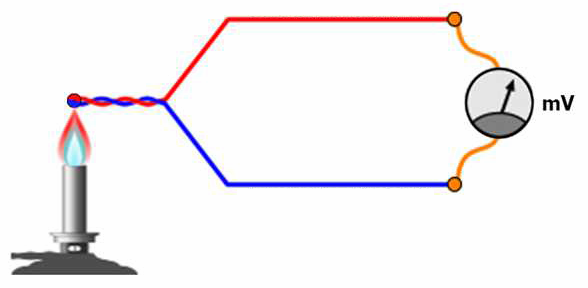Categories: Featured Articles » Novice electricians
Number of views: 5142
Comments on the article: 0
What is a thermocouple and how does it work
Thermocouples exist due to such a phenomenon as contact potential difference. If two different solid conductors or semiconductors are brought into close contact with each other, then separated electric charges are formed in the vicinity of the place of their contact. In this case, at the external ends of these conductors a potential difference will occur. This potential difference will be equal to the difference in the work function for each metal divided by the electron charge
It is clear that if you close such a pair into a ring, the resulting EMF will be zero, but if on the one hand it is still left open, then there will be a real EMF, ranging from tenths of a volt to units of volts, depending on what this is for the materials.
Of course, it is not possible to measure the contact potential difference with a voltmeter, however, it will manifest itself on the current-voltage characteristic, for example, it manifests itself in a transistor and in the diode on the p-n junction.
The bottom line is that when, for example, two metals come into contact, the system goes out of equilibrium because the chemical potentials of these two metals are not equal to each other, as a result, the electrons diffuse in the direction of decreasing their energy, which in turn leads to a change in charge and electrical potential of contacted metals. So in the near-contact region, the growth of the electric field begins, and as a result, we have what we have.

If now we again consider these two conductors of different metals, only closed in a ring, when the total emf in the closed circuit becomes zero, then we get two contact places. We will call these places junctions.
So, there are two junctions of two different conductors. What if you try to warm up one of the junctions, and leave the second at room temperature? Obviously, since the connected metals are different, and there is a contact potential difference in each joint, the junctions will experience different EMF deviations at different temperatures.
The experiment proves that the potential difference between the junctions will be proportional to the difference in their temperatures, so that you can enter the coefficient of proportionality, which is called thermo-EMF. For different thermocouples, thermo-EMF will be different.
If the voltage is measured in the context of such a ring, then in a certain temperature range it will be almost strictly proportional to the temperature difference of the junctions. And even if you leave only one junction (as in the figure), and only heat it up, and measure the voltage between two ends located at the same room temperature, you can still find a very clear dependence of the EMF on the current junction temperature. This is how thermocouples work.

The described phenomenon refers to thermoelectric, and the effect itself, on the basis of which all thermocouples work, is called Seebeck effect, in honor of his discoverer - Thomas Seebeck. Today you can find industrial thermocouples, in which, depending on the required measured temperature range, the electrodes are made from specially selected alloys.
For example, thermocouples made of chromel and alumel alloys have a thermo-emf coefficient of 40 microvolts per ° C, and are designed to measure temperatures in the range from 0 to + 1100 ° C. A pair of copper-constantan, so popular as a demonstration tool, allows you to measure temperatures from -185 to + 300 ° C.
Its thermo-EMF strongly depends on the specific temperature difference, therefore, to evaluate its parameters it is convenient to use the table, for example, at a cold junction temperature of 0 ° C, at a temperature difference of 100 degrees, the potential difference of the copper-constantan pair will be approximately 4.25 mV.
See also at bgv.electricianexp.com
:

